National Petroleum Agency
-
- Offshore Brazil: The Libra Field & Brazil’s Pre-Salt Policy Maritime Reporter, Nov 2013 #56
Brazil’s Libra pre-salt field, in Block SS-AUP1 in the Santos Basin, with estimated recoverable oil volumes of 8-12 billion barrels of oil equivalent (BOE) and in place volumes of between 25-40 billion BOE, was the country’s first pre-salt field to be auctioned.
The rules governing this historical auction have been shunned by important super-majors such as Exxon Mobil, Chevron and BP and also by major players such as the BG Group and Statoil. Many industry analysts were surprised that state-owned players from China, India and Malaysia dominated the list of companies that have agreed to the controversial terms imposed by the Brazilian government, through its National Petroleum Agency (ANP). Magda Chambriard, head of ANP, said that she had expected “more than 40 companies to bid for Libra,” expressing surprise at having only about a quarter that interest actually materializing. She may well have been surprised, but it is highly doubtful that the policy making nucleus in Brazil’s government was in any way surprised, as the state policy is to maintain tight control over pre-salt E&P. The new rules being implemented for this auction, such as Petrobras being the sole operator of the field and having a minimum 30% stake in any consortium, along with the highly criticized decision to create another state-owned company, Pré-sal Petroleo S.A. (PPSA), to act as manager of the winning consortium without imputing capital and having 50% vote in the Operational Committee’s deliberations, along with veto rights, are a reflection of the government’s policy.
Local industry analysts, who asked to remain unnamed, maintain that these and other new rules such as the production-sharing scheme were designed to attract other state-owned players, in detriment to the international super-major players, which are mostly private companies. The reasons for this preference is that these state-owned players participating in the auction, having significantly less, if any, experience in operating deepwater pre-salt fields, are therefore more agreeable to Petrobras’ operational control and the significant fact that these state-owned players are more interested in obtaining the physical oil than in the profits from oil sales because they need the oil for their own national development.
Eleven companies agreed to the auction terms and paid the roughly $1 million participation fee, after which they received the data package concerning the Libra field. Of these 11 companies, seven can be considered super-major players because of their market value, according to Bloomberg/PFC Energy estimates as of December 31, 2012. The fact that they paid the participation fee does not necessarily confirm that they would definitely participate in the auction, and the payment fee was compulsory and individual to each company, even those wishing to submit bids through a consortium. Therefore, some of the companies listed could choose to forfeit the fee and not participate in the auction, and one did just that; Repsol pulled out of the auction at the last moment. Additionally, Mitsui and Petronas failed to deposit financial guarantees, thus withdrawing participation rights. With the high investments involved, which include EWTs and other field development costs, along with around $7.5 billion as bonus on signing the 35 year long, nonrenewable E&P contract, virtually guaranteed that the companies involved will form consortiums, with no company competing individually. The ANP has estimated that it could take as much as $183 billion to develop the Libra field.
When the rules were changed in 2010, many local and international oil industry leaders and analysts expressed concern that the production-sharing model would reduce investment interest in Brazil’s pre-salt provinces, which include areas in the Santos, Campos and Espirito Santo Basins. After the rules were confirmed for the Libra auction, more than 200 requests for changes were made and turned down by the ANP, who said the area’s size and potential meant that the government could charge almost anything it wanted for the rights. “Libra is beyond any possible comparison nowadays to other fields,” said Magda Chambriard during a global road show to promote the auction.
“If companies participate, it is because they see potential value. This is the biggest auction in 30-40 years around the globe.”
Brazil’s government expects to receive around $300 billion in royalties and other taxes from Libra over 30 years.
Oil rights in the rest for Brazil’s post-salt plays will continue to be sold on a concession basis, where oil companies own all the oil, but pay royalties of at least 10% on production. João Carlos França, President of the Brazilian Petroleum Institute (IBP) had this to say: “What surprised me was Exxon not participating. But every company has its strategy. Libra is very large; it demands high investments, with high risk and many regulatory uncertainties in the sharing model. It’s not known how the PPSA will perform managing the fields. It’s a great doubt.”
The PPSA organization may be viewed with skepticism and considered a risk by some, but the fact is that the company was created specifically to manage the pre-salt resources efficiently. The risk is still there, yet by choosing a CEO with a technical background instead of a political appointee, President Dilma Rouseff showed how seriously the PPSA is being taken by the Brazilian government. This is an important indicator that the government expects the PPSA to keep a tight managerial and supervisory control over the winning consortium to guarantee that the oil costs (the costs related to oil production) do not skyrocket, which could adversely affect the amount of oil delivered to Brazil and the winning bidders.
Local content requirements for equipment and services also pose serious concerns to major players. According to executives from major oil companies operating in Brazil, there is a growing fear that local industry will not be able to fulfill demands and meet deadlines, thus slowing down Libra’s development and possibly even delaying Libra’s production startup, which would also delay any profit gains. By contract, the minimum local content during the exploratory phase is set at 37%. During the EWT, this drops to 15%. For the development phase modules to begin by 2021, local content requirements reach 55%, and for development phase modules beginning in 2022 this increases to 59%. President Dilma Rouseff announced in September, that the development of the Libra pre-salt field would require between 16-18 new rigs or FPSOs to reach the goal of producing 1 million BOE per day. This goal has since been raised to 1.4 million BOE per day. Between 60-90 support vessels are also forecast to be required. This will be a major boost to the already thriving Brazilian shipbuilding industry which has reached a workforce of roughly 70,000, up from an all-time low of only 2,000 workers at the turn of the century.
The President of PPSA will be Oswaldo Antunes Pedrosa Jr. He is a 63 year old engineer with a PhD from Stanford. Pedrosa worked for 30 years in Petrobras, where incidentally, he was chief of current Petrobras President, Graça Foster. After retiring from Petrobras he joined the ANP at its inception in 1998. Since 2010 he has been working with HRT O&G as Executive Director of the Polvo field, where HRT hold a 60% stake. “There needs to be a convergence of interests between the PPSA and its partners, including Petrobras as pre-salt operator.” Pedrosa said. “We also have to supervise the operator in order to guarantee that the main objectives of a company of this nature are reached. The main objective is to maximize the results for both the partners and the state. Now, during our operation, there will always be managerial conditions and procedures, which will allow the PPSA to reach high level agreements with the pre-salt operator, which is Petrobras.”
Libra Auction Result
With the first pre-salt auction scheduled to take place at a hotel located in Barra Beach on the west side of Rio de Janeiro during a commercial holiday on Monday, October 21, the Brazilian government made comprehensive security plans to impede demonstrators from reaching the event venue. Worker and teacher demonstrations have been commonplace in Brazil during the last few years, although they usually end in some form of confrontation with security forces. Before the bidding round started, there were demonstrations by oil workers and others totaling around one hundred people, about 500 meters from the venue, where the security cordon was placed. There were also confrontations with some demonstrators, and some of the 1,100 soldiers used as security suffered injuries.
Back at the event venue at the Windsor Hotel, there was a bit of an anticlimax, as in the end only one consortium deposited its bid in the ballot. With the lack of competition, the consortium comprised of Petrobras (10%), Shell (20%), Total (20%), CNPC (10%) and CNOOC (10%) offered the established minimum 41.65% in profit oil to the federal government, winning the first Pre-salt bidding round held by the Brazilian National Petroleum Agency (ANP). With the established a 30% stake to be acquired directly by Petrobras, the National Operator’s total participation in the consortium will be 40%. A signature bonus of around $7.5 billion is to be paid by the winning consortium in a single payment, and the total amount payable by Petrobras will be around $3 billion relative to its participation in the consortium. The contract states the block exploration phase will last four years. The minimum exploratory program, to be carried out during this period, includes 3D seismic for the whole block, two exploratory wells and 1 extended well test.
Petrobras highlights that recoverable oil volume estimates, costs, investments and schedule of the production systems of this block will be progressively released in a timely manner as the minimum exploration program is developed.
The national operator believes that the integration of expertise and experience of the European partners, Shell and Total, with their wide expertise in deepwater development and by their long experience in managing the design and implementation of large projects, will contribute to achieving good production results in Libra. The participation of the Chineses companies, CNPC and CNOOC, complements the requirements for a strong and active consortium, leveraged by the financial strength of the Chinese companies. Peter Voser, Chief Executive Officer of Royal Dutch Shell, said, “The Libra oil discovery in Brazil is one of the largest deep water oil accumulations in the world. We look forward to applying Shell’s global deep water experience and technology, to support the profitable development of this exciting opportunity.”
Brazilian President Dilma Rouseff, commenting on the complaints being made by the nationalist demonstrators, said, “According to the auction results, 85% of the total profit to be produced by the Libra field will be owned by the Brazilian State and Petrobras. This is very different to privatizing.”
He added, “Brazil is and will continue being a country open to national or foreign investment, which respects contracts and preserves its sovereignty. For all this, the Libra auction represents a marquee in the history of Brazil.”
Companies in first
Pre-Salt Auction
• CNOOC International Limited (China)
• China National Petroleum Corporation (CNPC) (China)
• Ecopetrol (Colombia)
• Mitsui & Co. (Japan)
• ONGC Videsh (India)
• Petrogal/Sinopec (Portugal-China)
• Petrobras (Brazil)
• Petronas (Malaysia)
• Repsol/Sinopec (Spain-China)
• Shell (Holland)
• Total (France)
Consortiums will be composed of a maximum of five companies.
(Source: ANP)
(As published in the November 2013 edition of Maritime Reporter & Engineering News - www.marinelink.com)
-
- Offshore Oil & Gas: Brazil’s Northern Frontier Marine Technology, Apr 2014 #34
has five offshore sedimentary basins; Foz do Amazonas Basin, Pará-Maranhão Basin, Barreirinhas Basin, Ceará Basin and Potiguar Basin. The ANP’s (National Petroleum Agency) 11th round of bidding, which took place in May 2013, finally opened up the Northern Frontier, also known as the Equatorial Margin (EM),
-
- Brazil Class Maritime Reporter, Jul 2013 #30
. We are also present in a special feature of the Brazilian market, which is Local Content certification, being accredited by Brazil’s ANP (National Petroleum Agency) for this purpose,” he said. “Brazil is a growing offshore market with almost unlimited potential and we are working closely with companies
-
- OSX: Full Speed Ahead on Mammoth Shipyard Project Maritime Reporter, Feb 2013 #30
company’s commitment to contract equipment and services produced in the Brazil, in accordance with the “Local Content” policy implemented by the National Petroleum Agency (ANP), led to the creation of OSX and its integrated solutions structured in three business units: chartering, shipbuilding and operational
-
 )
March 2024 - Marine Technology Reporter page: 23
)
March 2024 - Marine Technology Reporter page: 23. Submarine volcanoes are largely unknown, in contrast with their sub-aerial (above-ground) counterparts. Kevin Mackay, marine ge- ologist at the National Institute of Water and Atmosphere Research (NIWA), New Zealand, said, “There are over one million underwater volcanoes, although only about 120
-
 )
March 2024 - Marine Technology Reporter page: 8
)
March 2024 - Marine Technology Reporter page: 8in the northwestern Black They now pose a hazard to all maritime traf? c, regardless of Sea, which would not only have ceded control of Odessa, but national origin, prompting Turkey, Bulgaria, and Romania to enabled Russia to open up a second front. By all indications form a joint mine countermeasures
-
 )
March 2024 - Marine Technology Reporter page: 6
)
March 2024 - Marine Technology Reporter page: 6received Undersecretary and Assistant an honorary Doctor of Sci- Secretary of Commerce, acting and Deputy Administrator of the ence degree from Shang- National Oceanic and Atmospheric Administration (NOAA), and hai Ocean University in 2018. He proposed making thick wall Oceanographer of the Navy. He has
-
 )
April 2024 - Maritime Reporter and Engineering News page: 38
)
April 2024 - Maritime Reporter and Engineering News page: 38, Guatemala and El Salvador. Each ship will feature 300 Image courtesy HRDD refrigerated unit plugs. The four Avance-class ships are named after national birds, archaeological sites and lakes in Central lassNK granted its “SCCS-Full” class notation to America, Crowley said on social media. The newbuilds
-
 )
April 2024 - Maritime Reporter and Engineering News page: 28
)
April 2024 - Maritime Reporter and Engineering News page: 28FEATURE INTERVIEW track missiles and warheads for the Mis- sile Defense Agency, and it travels with its support ship, the MV Hercules. For our Service Support ships, we have the two hospital ships, USNS Mer- cy and Comfort; two rescue and salvage ships; two submarine tenders; and the Sixth Fleet ?
-
 )
April 2024 - Maritime Reporter and Engineering News page: 27
)
April 2024 - Maritime Reporter and Engineering News page: 27worked We are in that tough period with both recruiting and reten- their way up the “hawsepipe” from able bodied seaman to tion at the same time. It’s a national problem. master on our ships. We really want to grow our mariners We need to ensure our pay and bene? ts; the predictability from within. There’s
-
 )
April 2024 - Maritime Reporter and Engineering News page: 14
)
April 2024 - Maritime Reporter and Engineering News page: 14Book Review Approach to Meeting Underwater Radiated Noise Limits Def ned By Raymond Fischer uantitative underwater radiated noise limits will construction inspections, 5) possible training with respect to be developed shortly by IMO, and/or countries salient design/construction essentials, 6) compliance
-
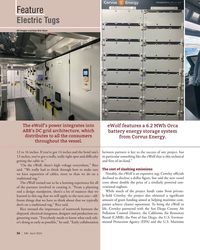 )
April 2024 - Marine News page: 34
)
April 2024 - Marine News page: 34Feature Electric Tugs All images courtesy Eric Haun The eWolf’s power integrates into eWolf features a 6.2 MWh Orca ABB’s DC grid architecture, which battery energy storage system distributes to all the consumers from Corvus Energy. throughout the vessel. 12 to 16 inches. If you’ve got 14 inches and
-
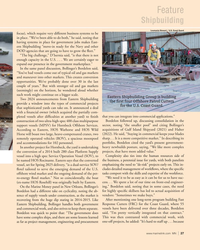 )
April 2024 - Marine News page: 27
)
April 2024 - Marine News page: 27Feature Shipbuilding Loumania Stewart / U.S. Coast Guard focus), which require very different business systems to be in place. “We’ve been able to do both,” he said, noting that having systems in place for government jobs makes East- ern Shipbuilding “move-in ready for the Navy and other DOD agencies
-
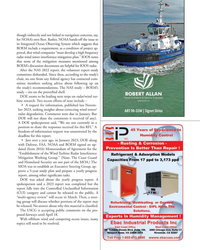 )
April 2024 - Marine News page: 25
)
April 2024 - Marine News page: 25though indirectly and not linked to navigation concerns, say, for NOAA’s own ? eet. Rather, NOAA hands-off the issue to its Integrated Ocean Observing System which suggests that BOEM include a requirement, as a condition of project ap- proval, that wind companies “must develop a high frequency radar
-
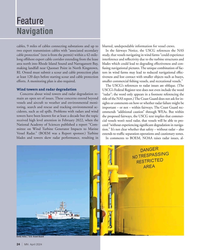 )
April 2024 - Marine News page: 24
)
April 2024 - Marine News page: 24USCG text implies that commer- received high level attention in February 2022, when the cial vessels won’t need radar, that vessels will be able to pro- National Academy of Sciences published a report “Com- ceed “without experiencing signi? cant degradation in naviga- mittee on Wind Turbine Generator Impacts
-
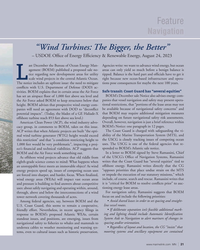 )
April 2024 - Marine News page: 21
)
April 2024 - Marine News page: 21Feature Navigation “Wind Turbines: The Bigger, the Better” – USDOE Of? ce of Energy Ef? ciency & Renewable Energy, August 24, 2023 ast December the Bureau of Ocean Energy Man- Agencies write: we want to advance wind energy, but ocean agement (BOEM) published a proposed sale no- areas can only yield so
-
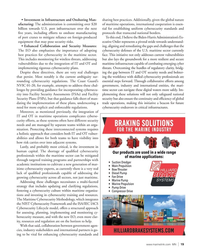 )
April 2024 - Marine News page: 19
)
April 2024 - Marine News page: 19Man- sharing best practices. Additionally, given the global nature ufacturing: The administration is committing over $20 of maritime operations, international cooperation is essen- billion towards U.S. port infrastructure over the next tial for establishing uniform cybersecurity standards and ? ve years
-
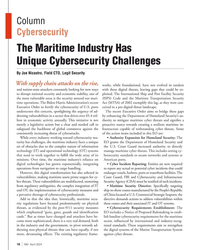 )
April 2024 - Marine News page: 18
)
April 2024 - Marine News page: 18not evolved in tandem and nation-state attackers constantly looking for new ways with these digital threats, leaving gaps that could be ex- to disrupt national security and economic stability, one of ploited. The International Ship and Port Facility Security the most vulnerable areas is the security around
-
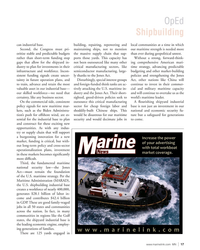 )
April 2024 - Marine News page: 17
)
April 2024 - Marine News page: 17mar- sector for cheap foreign labor and base is not just an investment in our kets, such as the Biden Administra- shoddily-built Chinese ships. This national and economic security fu- tion’s push for offshore wind, are es- would be disastrous for our maritime ture but a safeguard for generations sential
-
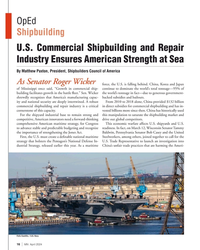 )
April 2024 - Marine News page: 16
)
April 2024 - Marine News page: 16the world’s tonnage in fact—due to generous government- shrewdly recognizes that America’s manufacturing capac- backed subsidies and bailouts. ity and national security are deeply intertwined. A robust From 2010 to 2018 alone, China provided $132 billion commercial shipbuilding and repair industry is a
-
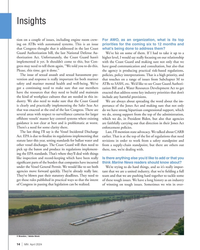 )
April 2024 - Marine News page: 14
)
April 2024 - Marine News page: 14six to 12 months and that Congress thought that it addressed in the last Coast what’s being done to address them? Guard Authorization bill, the last National Defense Au- We’ve hit on some of them. If I had to take it up to a thorization Act. Unfortunately, the Coast Guard hasn’t higher level, I would
-
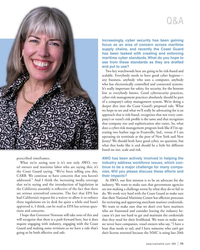 )
April 2024 - Marine News page: 11
)
April 2024 - Marine News page: 11. The fact that EPA has do. We work very hard with the Coast Guard to make sure had California’s request for a waiver to allow it to enforce that their National Maritime Center has ef? cient processes these regulations on its desk for quite a while and hasn’t for reviewing and approving merchant mariner
-
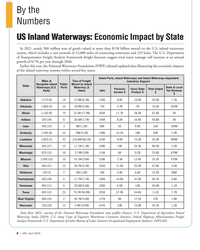 )
April 2024 - Marine News page: 8
)
April 2024 - Marine News page: 8Analysis Framework freight forecasts suggest total water tonnage will increase at an annual growth of 0.7% per year through 2040. Earlier this year, the National Waterways Foundation (NWF) released updated data illustrating the economic impacts of the inland waterway systems within several key states. Inland
-
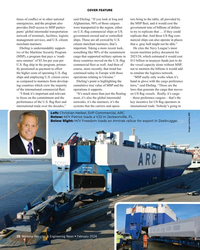 )
February 2024 - Maritime Reporter and Engineering News page: 28
)
February 2024 - Maritime Reporter and Engineering News page: 28COVER FEATURE times of con? ict or in other national said Ebeling. “If you look at Iraq and tors bring to the table, all provided by emergencies, and the program also Afghanistan, 98% of those cargoes the MSP ? eet, and it would cost the provides DoD access to MSP partici- were transported to the
-
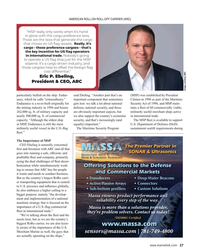 )
February 2024 - Maritime Reporter and Engineering News page: 27
)
February 2024 - Maritime Reporter and Engineering News page: 27the cargo that moves on US ? ag vessels. Really, it’s cargo – those preference cargoes – that’s the key incentive for US ? ag operators in international trade. Nobody’s going to operate a US ? ag ship just for the MSP stipend. It’s a cargo driven industry, and those cargoes help to offset the foreign
-
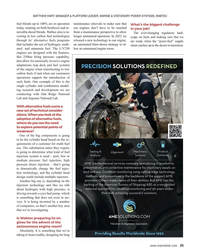 )
February 2024 - Maritime Reporter and Engineering News page: 25
)
February 2024 - Maritime Reporter and Engineering News page: 25of such fuels. One example of this is the single cylinder and combustion model- ing research and development we are conducting with Oak Ridge National Lab and Argonne National Lab. With alternative fuels come a new set of technical consider- ations. When you look at the adoption of alternative
-
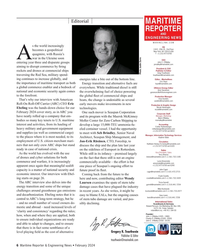 )
February 2024 - Maritime Reporter and Engineering News page: 6
)
February 2024 - Maritime Reporter and Engineering News page: 6are [email protected] a global commerce enabler and a bedrock of everywhere. While traditional diesel is still Offshore Energy Editor Amir Garanovic national and economic security again comes the overwhelming fuel of choice powering [email protected] to the forefront. the global ? eet
-
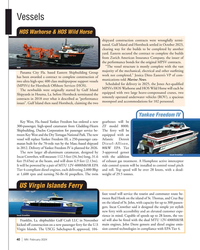 )
February 2024 - Marine News page: 40
)
February 2024 - Marine News page: 40from Gladding-Hearn ZF model 8000. Shipbuilding, Duclos Corporation for passenger service be- The ferry will be tween Key West and the Dry Tortugas National Park. The new equipped with an vessel will replace Yankee Freedom III, a 250-passenger cata- Atlantic Detroit maran built for the 70-mile run by
